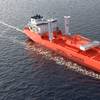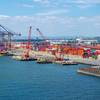Seattle's MARCO shipyard has been completing a rush job for Great Lakes Towing affiliate TUGZ International and is expected to have three new tractor tugs ready for christening by February 13. At the same time, the yard has just started to cut steel for two slightly larger tractors being built for San Francisco-based BayDelta.
The latter will measure 105 ft. and will be powered by twin Caterpillar diesels of 4,400 combined hp driving Ulstein Z-drive units fitted with high-performance Nautican nozzles. Towing winches and headline winches will be provided by Burrard Iron Works Ltd of Vancouver, B.C. The three TUGZ boats, to be christened Z-Three, Z-Four and Z-Five, are 95-ft., and will also make use of Caterpillars turning Ulstein z-drives. All three are being fitted with a special fendering system designed specifically for use in submarine assist work as they will be employed under long-term contract by the Navy at Pearl Harbor, Hawaii.
In addition to the custom loop fendering, designed by Schuyler Rubber, the boats will feature sponsons astern to ensure the nozzles never come in contact with the submarine hulls. MARCO has become a tug builder of some renown over the past half-decade, but it is more widely known on the international market for its pollution control equipment and fishing gear.
The name MARCO comes from Marine Construction and Design Company, which is the name Peter Schmidt used when he formed the company in Seattle more than four decades ago. One of the most innovative MARCO early products was the Puretic Power Block, invented by Mario Puretic and produced by MARCO in the early 1950s.
The Block, which allowed a quick and safe recovery of fishing nets, revolutionized the world's net-fishing industry and allowed MARCO's machinery division to expand into deck winch, steering machinery and seine winch production during the post-war years.
In 1958, Schmidt traveled to Chile and set up MARCO's first overseas venture, MARCO Chilena at Iquique, Chile. Another Latin American venture was Fabricaciones Metalicas S.A. (Fabrimet) of Callao, Peru, formed around a licensing agreement - MARCO's first - under which the Peruvian firm built 60-ft. seiners to MARCO's design. In 1979, MARCO obtained control of Campbell Industries of San Diego, which had a small shipyard dealing in the repair and construction of tuna vessels. The yard witnessed financial difficulties in the early 1980s, but under Schmidt's leadership, was turned around and over the next three years delivered eleven 221-ft. tuna seiners and one 137-ft. seiner, almost all going to overseas owners.
These were followed by the 257-ft. Super Pacific class, with two built for French owners, four for South Korean firms, and one each for Italian and U.S. interests. Over the past several years the Campbell facility has shifted its expertise to the repair and construction of luxury yachts, including 219-ft. Golden Shadow, the largest private yacht completed in a U.S. yard since the 1930s.
In the pollution control arena, MARCO's oil recovery system has become an industry leader. The heart of the system is the MARCO filterbelt, originally developed for the USCG in the late 1960s by Dr. J.L. McGrew of the Martin Marietta Company. Today, more than 150 oil recovery vessels around the world are outfitted with the MARCO Filterbelt, one of the latest being a 38-ft. "Convertible" oil spill recovery vessel (OSRV) completed by Seattle's Kvichak Marine Industries for Clean Sound Coopertive.
According to Kvichak's Jennifer Rose, who has also worked for MARCO, the new OSVP incorporates two different skimming systems into one skimming platform, a MARCO 12-in. Filterbelt and a LORI 3-chain Brush Pack. Rose said both technologies are unaffected by the floating debris normally found in an oil slick and the vessel operator can choose which recovery module is best suited to operating conditions and oil slick characteristics.
MARCO's Filterbelt system was used in the Exxon Valdez incident as well as the Mega Borg spill in the Gulf of Mexico and the American Trader grounding in Southern California. In conjunction with the development of its Filterbelt system, MARCO has introduced three offshore VOSS (Vessel of Opportunity Skimming System) products. It has also designed combination vessels for overseas firms.
One such is 108-ft. Special Oil Recovery Tug (SORT) No. 3 Tao Yu, built by the Lien Ho Shipyard of Taiwan to a MARCO design for the Chinese Petroleum Corporation. This vessel combines the characteristics of a reverse tractor tug with those of an open ocean oil recovery vessel and is also equipped with fire fighting capabilities consisting of two four-in. monitors delivering up to 3,000 gal. per min. of water or foam.
Although the 3,700 hp SORT's primary mission is to provide shiphandling assistance at oil terminals, in the event of an oil spill, it can be converted in a matter of minutes to a fully self- sufficient oil recovery system with a sweep width in excess of 60 ft. and a recovery rate of up to 2,600 barrels per hour.
This is accomplished using two three-ft. wide MARCO filterbelts feeding into a 600 barrel capacity onboard storage tank. Other owners are studying this type of system as an economical means of providing pollution control capabilities within the hull of a general purpose, ship assist or escort tug. Its high range of diversity, which has also included high-speed hull work, has given MARCO a secure position in the Pacific Northwest marine scene.-J.L. Shaw
Sponsored Content
Lower carbon intensity fuels to support your operations

Subscribe for
Maritime Reporter E-News
Maritime Reporter E-News is the maritime industry's largest circulation and most authoritative ENews Service, delivered to your Email five times per week










